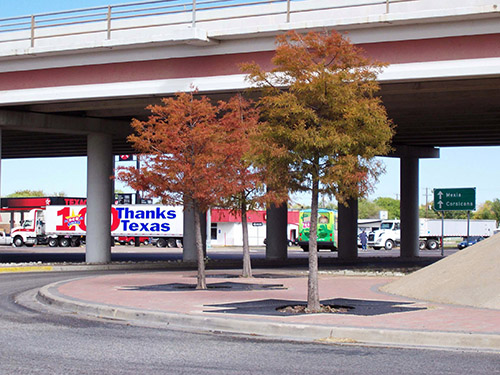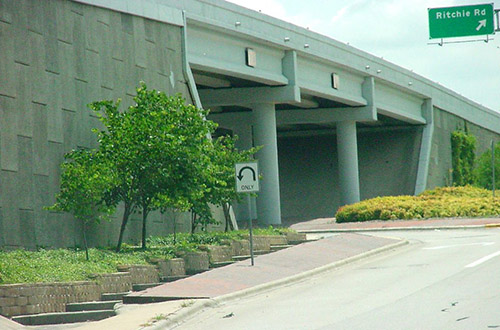In the midst of ongoing construction, demolition and traffic upheaval, I-35 travelers can look forward to wildflowers, trees and greenery as the light at the end of a concrete tunnel. Over the last four years, TxDOT landscape architects have begun pushing attractive landscapes and revegetation to the forefront of the I-35 agenda.
Where there were once miles of flat concrete retaining walls and stark concrete crossings, completed portions of I-35 now boast attractive gateway markers, native trees and bluebonnets. "Highway landscaping plans started out as purely erosion control, but now we've put more focus on aesthetic appeal and community identification," says TxDOT Landscape Architect Betsy Pittman.
When you think of I-35, the importance of "highway beautification" and "aesthetic appeal" may not immediately come to mind. Some Texas drivers wonder how significant landscaping around the interstate actually is; Pittman says the beautification not only enhances the driver's traveling experience, but can also benefit the economies of the highway's surrounding cities and even support beneficial wildlife (including important crop pollinators like honeybees and butterflies).
Cities on the interstate, such as Troy, Temple and Salado, take on the maintenance of the roadside landscapes after the highway's contractors are done. "Cities will maintain the projects once we've completed the construction," Pittman says. This often gives local landscaping companies an opportunity to benefit from the work required to maintain the projects.

The various communities also have a large say in choosing what their portion of the interstate's landscape will look like. Because of the responsibilities of maintaining the greenery, cities collaborate with TxDOT on landscaping suggestions.
Texas is well known for its beautiful wildflowers, especially the bluebonnet and the Indian paintbrush. Less well known are the economic benefits those colorful views generate. "Wildflowers also have a huge tourism draw," explains Pittman.
While these wildflowers take the spotlight on drawing newcomers to the Lone Star State, they also play an important role in erosion control and preventing pollution runoff from the highways. Wildflower seedlings, shrubs and grass create barriers for highway runoff, and root structures play a pivotal role in keeping pollutants from seeping into cities' underground water systems.

Construction of the improved highway brings inevitable demolition with it; bridges must come down and roads must be expanded. However, TxDOT landscape architects do their best to work with communities on mitigation and replenishing vegetation that must be sacrificed. "We replace anything we had to take out," Pittman said, "even if it's not immediately next to the highway." With each new project, landscaping crews replenish trees (pecans are currently a popular choice), shrubs and wildflowers conducive to aesthetic appeal and wildlife promotion.
Using plants and grass to soften the hardscape that comes with roads, drawing attention to each individual community along the interstate, and using allotted funds and grants to the benefit of area ecologies and economies, landscaping can prove to be a pivotal and financially responsible element in residents' and visitors' experiences on the highways of Texas.
Jake Smith
I-35 Public Information Officer
254-867-2705
Contact My35